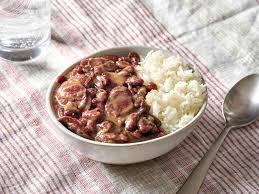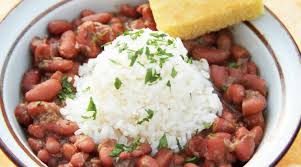Red Beans and Rice
Preparing red beans and rice from the beginning is simple; you just need beans, vegetables, a bit of cured pork and sausage, along with some patience.
Reasons for Effectiveness
- Soaking beans in saltwater makes them more tender when cooked.
- Various cured pork items add rich flavor to the beans.
- The person who coined the phrase "a case of the Mondays" likely hasn't experienced much time in New Orleans.
Visit any traditional restaurant in New Orleans on a Monday, and you’ll probably see red beans and rice featured as a special. An even superior idea: Receive an invitation to a home in New Orleans. Why have red beans and rice on a Monday? According to the legend, hams were prepared on Sundays, while Mondays were typically reserved for doing laundry. Women required a Monday meal that could prepare itself, without supervision, as they focused on washing clothes. A large pot of red beans cooking on the stove (seasoned with leftover Sunday ham bones) was the ideal answer.
What I can say for certain is this: New Orleans-style red beans and rice is incredibly delicious. Aromatic, zesty, robust, and incredibly soothing. For someone accustomed to having a large portion of protein at the center of their plate for each meal, it may be difficult to conceive that beans and rice can serve as a complete meal on their own in various countries globally. If there's a variation that might sway you, it's red beans and rice from New Orleans.
Despite the rich complexity of its flavor, the list of ingredients and the preparation are quite straightforward. A small selection of vegetables, a few standard pantry spices, a pair of fresh herbs, some pieces of pork, and several red kidney beans. Let’s examine every stage of the procedure.
Selecting and Soaking the Beans
Though red beans and rice is the best-known version of this dish, it is frequently made with other types of beans, and you can do the same if you'd like. Pink beans, white cannellini beans, even black beans will all taste great with the same basic technique. If you want to go with true red beans, pick up some dried red kidney beans.
You could make a quick version of red beans and rice with canned beans, but if you want really creamy texture and the best flavor, dried beans are the way to go. Some recipes suggest that you can cook the beans straight from dried without an overnight soak. You can, but it extends the actual cooking time by several hours, and I found that the results were not quite as creamy or evenly cooked.
For the best results, soak the dried beans overnight in salted water. Salt can help soaked beans cook more evenly, as salt ions replace magnesium and calcium ions in the bean skins, allowing them to tenderize more readily. Salting the cooking liquid will also aid in this process. (The whole idea that salting the water prevents beans from softening is an easily disproven myth.)
The Holy Trinity of Vegetables
Red beans and rice begins, similar to many other Cajun and Creole recipes, with the "Holy Trinity" of vegetables: onion, celery, and bell pepper. Similar to France's mirepoix or Italy's battuto, these vegetables are minced and introduced to the pot at the beginning of cooking, where they will ultimately dissolve and create the dish's flavor foundation.
I attempted to sweat my vegetables using lard, vegetable oil, and shortening, and discovered that the variations among them were rather minimal. If you're ready to commit, sauté the vegetables in lard. If you're aiming to achieve 98% of the result without needing to source lard from the butcher, using vegetable oil or shortening works perfectly well.
The secret is to cook the vegetables slowly, seasoning them to extract moisture and mixing them until they are very tender but not yet browned. As soon as they reach this stage, I incorporate a couple of minced garlic cloves and sauté the garlic until it becomes aromatic.
Herbs and Seasonings to Include in the Pot
Following that are the dried seasonings. It's unnecessary to be excessive with the spice collection: Several trusted recipes, such as this one from New Orleans specialist Emeril Lagasse, have little to no spices, instead depending entirely on the pork for additional flavor. In my recipe, I prefer to use only a few spices—black pepper and cayenne for added heat, along with ground sage for its earthy taste.
Certain recipes call for dried thyme, but I favor the taste of fresh thyme in stews. Harvesting single leaves? No one has time for that. I simply toss the whole sprigs directly into the pot and let me deal with removing the stems once the cooking is complete. It's considerably simpler.
The only additional aromatics I incorporate are several bay leaves. (Absolutely, bay leaves are essential!)
Selecting Your Meat
Typically, I prefer using chicken stock to cook beans instead of just water to enhance the flavor. You can accomplish that here too, but it’s nearly unnecessary. We're including so many pieces of pork that the dish practically creates its own broth as it cooks.
Andouille sausage is essential; it adds a zesty, cured taste and a lot of flavorful richness. To enhance its flavor infusion, I prefer to include the sausage in the stew from the beginning, even prior to adding the vegetables. This allows it to brown slightly, while offering more rendered fat for the vegetables to sauté in.
Tasso, a frequently used ingredient, imparts smokiness, and its rind contributes gelatin to enhance the liquid's body. Regrettably, tasso is quite difficult to locate in many areas of the country. I opt for smoked ham hocks instead. They may not be identical, but they are still tasty.
The truly distinctive component—one that isn't always needed, even in genuine recipes—is pickled pork shoulder. It contributes a delightful brightness to the beans (though they'll remain quite tasty without it). Pickled pork, consisting of vinegar-brined pork shoulder, can be even more difficult to locate than tasso.
If you want to prepare it on your own, Alton Brown offers a solid recipe. If you'd rather avoid it, incorporating a splash of cider vinegar into the cooked beans can effectively replicate that pickled taste.
Cooking the Beans Slowly
After placing everything in the Dutch oven, together with the drained beans and sufficient fresh water to cover them, bring it to a simmer, cover the pot, and step away to handle your laundry.
However, avoid expecting too many loads. I'm unsure if it's due to soaking my beans or if beans used to be harder in the past, but I notice that my beans become perfectly tender within one and a half to two and a half hours.
You can keep cooking them covered even when they're completely tender—this is one of those meals that can handle a little overcooking—but if you're like me, the scent will be so incredibly enticing that you'll want to serve it at the dinner table as quickly as you can.
After removing the lid, it will require approximately 20 more minutes of simmering to achieve the proper creamy thickness by reducing the liquid. The freshness of the beans can affect how quickly they release their creamy starch, so in some situations, you may notice that the liquid evaporates before the beans have released enough starch to achieve the desired creaminess in the pot. If this occurs, simply add a bit more water to the pot and continue simmering until you achieve the desired texture.
To complete the dish, drizzle it with a tangy hot sauce, such as Crystal or Frank's, then remove the bay leaves and thyme stems (or skip this step and simply advise your guests before they start eating). If you wish, you can pull apart the meat from the ham hock, or shred the pickled pork or tasso, if you opt for those items.
Some individuals, who possess more patience than I do, claim that allowing the beans to cool and serving them the following day will enhance their flavor. Similar to my experiments with stews, I noticed that the flavor didn't alter significantly with time, but the texture definitely does. Red beans that are reheated are creamier than those made the same day, so if you can manage to wait, storing them in the fridge overnight is beneficial.
However, I won't fault you if you choose not to.
Distribute the bowls of rice, carry the entire pot to the dining table, and allow everyone to help themselves. They're going to desire more.
Notes
Finding pickled pork can be challenging, and the beans can be made quite easily without it. If you skip the pickled pork, a little splash of cider vinegar can enhance the beans' flavor, though it's not absolutely essential. Incorporate it to match your personal preferences.
Fixings
- 2 tablespoons olive oil
- 1 huge onion, generally cleaved
- 1 green chime pepper, cleaved
- 2 stems celery, cleaved
- 2 tablespoons garlic, minced
- 1/2 teaspoon cayenne pepper
- 1 teaspoon thyme
- 3/4 teaspoon sage
- 1 tablespoon dried parsley
- 1 teaspoon Cajun preparing, more to taste
- 1 tablespoon sugar
- 1 teaspoon Better Than Bouillon Chicken Base
- around 7 cups water
- 1 pound dry red beans, rinsed*
- substantial ham bone or pork shank
- 2 straight leaves
- 1 and 1/2 to 2 teaspoons salt
- 6-8 cups hot cooked rice
Directions
- Prep your veggies: cleave the onion, chime pepper, and celery. I like to cleave the finishes of the celery
- Heat the oil in a huge pot over medium high hotness.
- When it is hot and gleaming, add the cleaved onion, ringer pepper, and celery. Saute for 6-8 minutes, until the onions begin to become clear.
- Mince the garlic. In a little bowl, consolidate cayenne pepper, thyme, sage, parsley, Cajun preparing, and sugar.
- Add the garlic and flavors to the pot and saute for 1-2 minutes, until fragrant.
- Add 1 teaspoon Chicken Base.
- Add around 7 cups of water and 1 pound of washed red beans. Add the ham bone or pork shank. Add the sound leaves.
- Mix it all together over high hotness until it reaches boiling point. Turn the hotness down to a low stew, so it is scarcely percolating.
- Cover with a top and save it at a low stew for 2 and 1/2 to 3 hours. Partially through the cooktime, either eliminate the top or slant it with the goal that the beans can vent.
- 30-an hour prior to the beans are done, add 1-2 teaspoons salt.
- Following 2-3 hours, taste the beans. They ought to be delicate and delightful. Assuming they are at all dry or powdery, continue to cook.
- Add salt to taste. Add more Cajun preparing to taste.
- Eliminate the ham bone and narrows leaves. Slash any meat left on the bone and return the meat to the beans. Dispose of the bone.
- Present with hot rice.Enjoy it!
Red Beans and Rice VIDEO :




